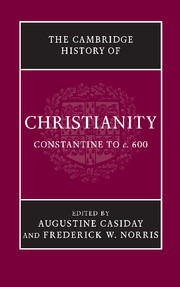Book contents
- Frontmatter
- Introduction
- Part I Christianity: Regional Developments
- Part II Christianity Contested
- Part III Christian Culture and Society
- Part IV Christian Beliefs and Practices
- 18 Discourse on the Trinity
- 19 History of Christology to the seventh century
- 20 Sin and salvation: Experiences and reflections
- 21 From Antioch to Arles: Lay devotion in context
- 22 Saints and holy men
- 23 Pastoral care and discipline
- 24 Sexuality, marriage and the family
- 25 The growth of liturgy and the church year
- 26 Interpreting scripture
- 27 Asceticism and monasticism, I: Eastern
- 28 Asceticism and monasticism, II: Western
- 29 Art and Propaganda fide: Christian art and architecture, 300–600
- Index
- Map 1 The Roman empire, c. 400">
- References
22 - Saints and holy men
from Part IV - Christian Beliefs and Practices
Published online by Cambridge University Press: 28 March 2008
- Frontmatter
- Introduction
- Part I Christianity: Regional Developments
- Part II Christianity Contested
- Part III Christian Culture and Society
- Part IV Christian Beliefs and Practices
- 18 Discourse on the Trinity
- 19 History of Christology to the seventh century
- 20 Sin and salvation: Experiences and reflections
- 21 From Antioch to Arles: Lay devotion in context
- 22 Saints and holy men
- 23 Pastoral care and discipline
- 24 Sexuality, marriage and the family
- 25 The growth of liturgy and the church year
- 26 Interpreting scripture
- 27 Asceticism and monasticism, I: Eastern
- 28 Asceticism and monasticism, II: Western
- 29 Art and Propaganda fide: Christian art and architecture, 300–600
- Index
- Map 1 The Roman empire, c. 400">
- References
Summary
The period beginning around the year 300 was a time of experimentation with expressions of faith, piety and belief. The legitimating of Christianity at the end of the Persecutions in 312 and the prospect of lasting imperial support for Christianity and its practitioners opened up new opportunities for social acceptance and public expression of the faith. By around the year 600, experimentation had turned to solidification and a firm groundwork was established that future generations would evoke as binding precedent. One of the great novelties of the period was the cult of saints.
The focus of studies on saints has commonly been on ‘the very special dead’, as Peter Brown has called them, centred on the cult at their tomb. Yet, other influential publications of the same scholar have drawn attention to the importance of living ‘holy men’ within the socio-economic landscape of late antiquity. There is no clear dividing line between them in terms of the veneration they received. Dead saints and living holy men alike were believed to hold a special connection to the divine that they were able to share with those who approached them. As will emerge from the following, many acts of veneration shown to saints after their death had their origin in the connections of the faithful to living holy men.
- Type
- Chapter
- Information
- The Cambridge History of Christianity , pp. 548 - 566Publisher: Cambridge University PressPrint publication year: 2007

